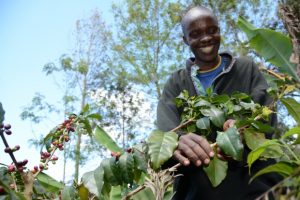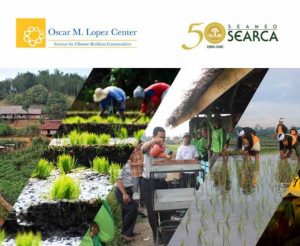 How does a guy from a sleepy country town in Victoria end up pioneering a way to transform the drought-ravaged land into ribbons of greenery?
How does a guy from a sleepy country town in Victoria end up pioneering a way to transform the drought-ravaged land into ribbons of greenery?
Three decades ago Tony Rinaudo was hurtling across the sandy plains of Niger in a clapped-out ute with a trailer-load of trees.
The Victorian man was in the west African country to manage a tree planting project.
“Basically it was a failure. We were only planting 6,000 trees per year, most of them died, and people were not interested. I was very frustrated. I felt I was just wasting my time and others’ money in a project that would never have an impact,” he says.
As he adjusted the pressure of his tyres in preparation for the sandy road ahead, Rinuado surveyed the land stretching out in all directions: scorched and drought-ridden. He’d witnessed how farmers struggled to put enough food on the table even in ‘good’ years.
He was almost ready to pack his bags and leave.
But something caught his eye: a tiny shrub, feebly fluttering its leaves in the glare of the sun. On closer inspection, he noticed it wasn’t a shrub; it was a tree attempting to re-grow. This little tree got his mind ticking over: perhaps he was thinking about the revegetation issue all wrong. Instead of planting more trees, why not take advantage of sprouting root systems or seeds that lie underground?
From this simple idea, he developed the “Farmer Managed Natural Regeneration”(FMNR), a method of taking advantage of root systems – memories of their former tree selves – that lie dormant beneath the ground. He’s quick to clarify he didn’t actually invent FMNR, it was more of a “rediscovery” of a traditional practice that dates back centuries.
Rinuado says the result of this radical approach to land management has been “quite amazing”. Hundreds of thousands of farmers embraced this agricultural practice, transforming large swaths into productive land, improving food and fuel production for their communities. Once the revegetation takes off, the farmers just need to protect the tiny, growing tree shoots from theft, fire and livestock. And the results speak for themselves: satellite images show how far FMNR has spread across Africa’s desert plains: Niger boasts vast swathes of vegetation, whereas in Nigeria, just across the border where FMNR hasn’t been introduced, it’s strikingly barren.
Click here for the full article
Originally published on News.Com.Au


 Much news reporting disregards one of the most serious environmental challenges of our time: desertification and land degradation. As Monique Barbut, Executive Secretary of United Nations Convention to Combat Desertification (UNCCD) says: “
Much news reporting disregards one of the most serious environmental challenges of our time: desertification and land degradation. As Monique Barbut, Executive Secretary of United Nations Convention to Combat Desertification (UNCCD) says: “ In order to prepare for climate change, farmers need to understand what their future climate is likely to be. As 70% of expected future climates already exist somewhere else on the globe, farmers can start preparing for their future by learning from sites with similar climates.
In order to prepare for climate change, farmers need to understand what their future climate is likely to be. As 70% of expected future climates already exist somewhere else on the globe, farmers can start preparing for their future by learning from sites with similar climates. ICRAF’s South Asia Programme and the EverGreen Agriculture Partnership convened a two-day meeting dubbed EverGreening India on 31 August and 1 September 2017, at the NASC Complex, Pusa, New Delhi. This discussion was a follow-up to an initial meeting held in February 2015. The event brought together 40
ICRAF’s South Asia Programme and the EverGreen Agriculture Partnership convened a two-day meeting dubbed EverGreening India on 31 August and 1 September 2017, at the NASC Complex, Pusa, New Delhi. This discussion was a follow-up to an initial meeting held in February 2015. The event brought together 40 The areas with degraded landscapes in Southeast Asia are expanding rapidly. The Conservation Agriculture with Trees (CAWT) strategy is the best “tool box” for sustainable crop production intensification. CAWT follows the Landcare approach, with principles and practices founded on minimal soil disturbance, continuous mulching, pests and nutrients management, species rotations, integration of trees, and rainwater harvesting.
The areas with degraded landscapes in Southeast Asia are expanding rapidly. The Conservation Agriculture with Trees (CAWT) strategy is the best “tool box” for sustainable crop production intensification. CAWT follows the Landcare approach, with principles and practices founded on minimal soil disturbance, continuous mulching, pests and nutrients management, species rotations, integration of trees, and rainwater harvesting. Kenya is on course to reduce the effects of climate change, the Government has said. Environment Cabinet Secretary Judi Wakhungu listed banning of plastic bags, planned restoration of 5.1 hectares of land under forest and promotion of renewable energy as some of the measures the Government had taken to reduce carbon emissions.
Kenya is on course to reduce the effects of climate change, the Government has said. Environment Cabinet Secretary Judi Wakhungu listed banning of plastic bags, planned restoration of 5.1 hectares of land under forest and promotion of renewable energy as some of the measures the Government had taken to reduce carbon emissions.